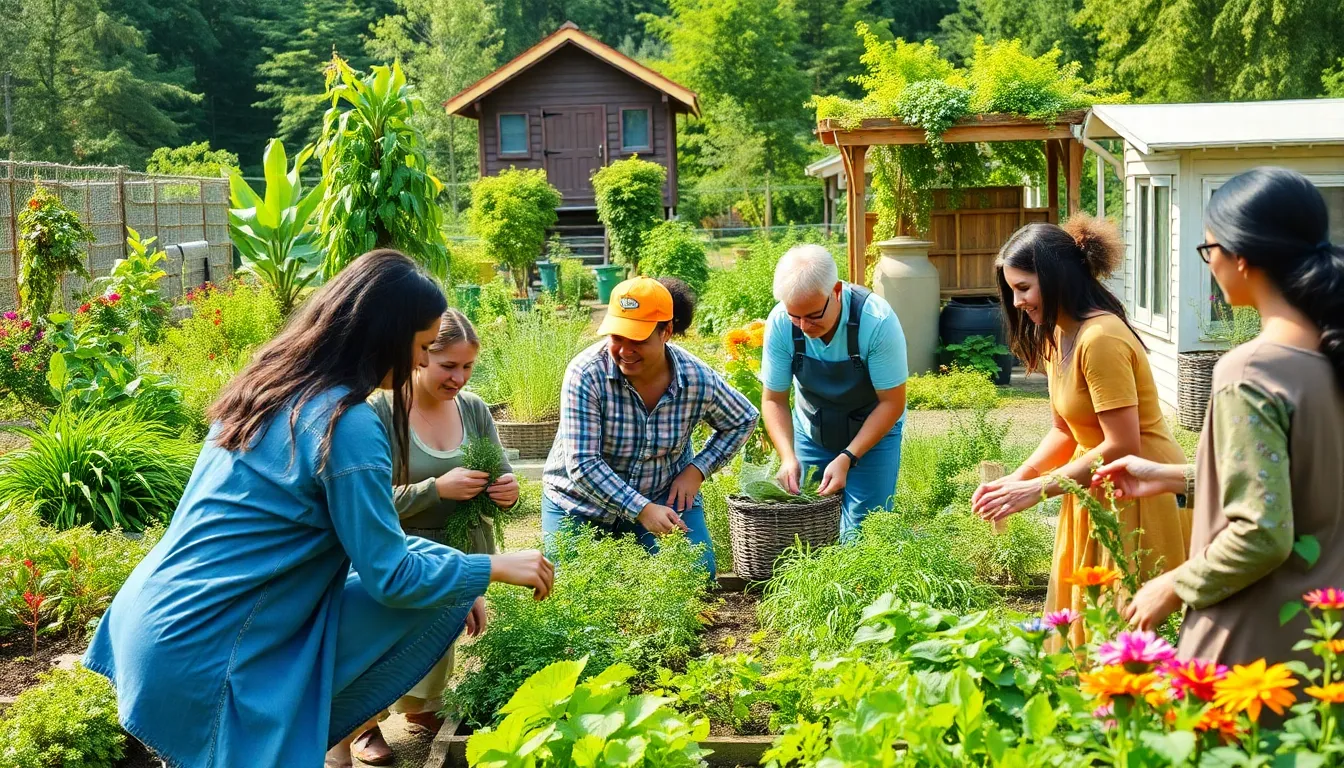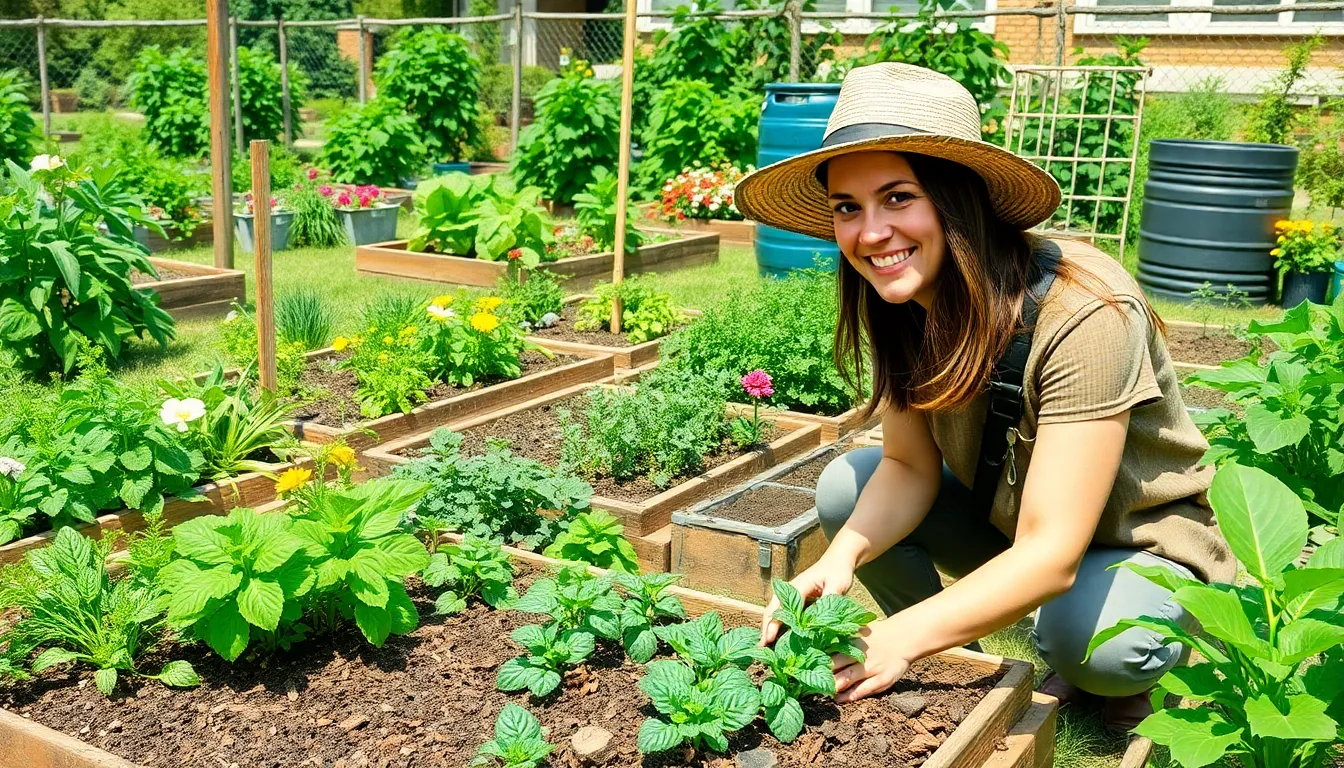Imagine stepping into a garden that practically runs itself, where plants and nature work together in perfect harmony. Welcome to the world of permaculture gardening! It’s not just a trend; it’s a sustainable lifestyle choice that transforms any plot of land into a thriving ecosystem.
Table of Contents
ToggleOverview Of Permaculture Gardens
Permaculture gardens embody sustainable practices designed to create self-sufficient ecosystems. These gardens utilize natural resources efficiently while minimizing waste. Key principles drive this gardening approach, including diversity, resilience, and integration.
Diversity within permaculture gardens enhances resilience. By planting various species, gardeners promote biodiversity, which strengthens the ecosystem and protects against pests. Incorporating companion plants can lead to improved growth rates and yields.
Soil health plays a crucial role. Techniques like mulching, composting, and crop rotation enrich the soil. Healthy soil supports not only plant life but also beneficial organisms that contribute to the ecosystem.
Water management is another essential component. Utilizing rainwater harvesting systems and swales effectively conserves water. These strategies ensure plants receive adequate moisture while reducing reliance on external water sources.
Permaculture gardens also emphasize the importance of local climate and conditions. Design elements like shade structures and windbreaks optimize growing environments. Gardeners adapt to seasonal changes, enhancing productivity and sustainability.
Community involvement fosters connections and knowledge-sharing. Collaborating with neighbors creates a network of support, leading to shared resources and experiences. Educational workshops facilitate the growth of permaculture principles across broader communities.
This approach to gardening aligns with ecological ethics, promoting stewardship of the environment. Practicing permaculture cultivates not only gardens but also a philosophy of sustainable living. The result is a thriving ecosystem that benefits both humans and nature.
Principles Of Permaculture

Permaculture principles guide the creation and maintenance of sustainable ecosystems in gardening. These principles focus on efficiency, conservation, and collaboration.
Ethics Of Permaculture
Ethics form the foundation of permaculture, emphasizing care for the earth, care for people, and fair share distribution of resources. Care for the earth fosters biodiversity, soil health, and ecosystem stability. Care for people supports community engagement, inclusivity, and shared responsibility. Fair share promotes equitable resource allocation, limiting consumption and waste. By adhering to these ethics, permaculture practitioners cultivate a more sustainable relationship with the environment and each other.
Design Principles
Design principles in permaculture promote harmony between various elements of a garden. Observing landscapes allows gardeners to identify natural patterns and microclimates. Integrating diverse plants creates an ecosystem that functions holistically. Zoning helps prioritize elements based on their usage frequency, reducing effort in maintenance. Appropriate technology minimizes human intervention and maximizes efficiency. Implementing these design principles creates resilient and self-sustaining gardens that thrive while minimizing ecological impact.
Benefits Of A Permaculture Garden
Permaculture gardens offer numerous advantages that extend beyond aesthetic appeal. They promote ecological balance while providing practical benefits to individuals and communities.
Environmental Impact
Permaculture gardening significantly improves soil quality through practices like mulching and composting. Enhanced biodiversity occurs by incorporating various plant species, leading to a resilient ecosystem that naturally combats pests. Water management techniques such as rainwater harvesting optimize resource use. Carbon sequestration takes place as plants grow and accumulate biomass, contributing to a healthier atmosphere. Wildlife habitats flourish, encouraging beneficial insects and other organisms to thrive. Sustainable practices reduce reliance on chemical fertilizers and pesticides, decreasing environmental harm.
Economic Sustainability
Cost savings emerge from reduced expenses on fertilizers and pesticides due to natural pest control and rich soil. Gardens become self-sufficient, producing food that reduces grocery bills. Communities benefit from shared resources, allowing individuals to exchange crops or tools, fostering collaboration. Value increases as properties with permaculture gardens often experience higher market demand. Education and skills development in gardening practices enhance local economies, creating job opportunities in sustainability-focused sectors. Overall, permaculture cultivates an economic framework that supports long-term sustainability.
Health Advantages
Nutrient-rich produce results from permaculture gardens, offering fresh fruits and vegetables that promote well-being. Access to organic food reduces exposure to harmful chemicals found in conventional agriculture. Mental health benefits include increased relaxation from spending time in nature, fostering mindfulness and reducing stress. Physical activity becomes integral to gardening, encouraging movement and enhancing fitness. Community involvement further strengthens social bonds, providing support networks that contribute to overall wellness. Engaging in permaculture encourages healthier lifestyles, resonating with individuals and families alike.
Steps To Create A Permaculture Garden
Creating a permaculture garden involves several key steps that ensure a sustainable ecosystem thrives. Each step contributes to the overall success of the garden.
Site Assessment
Evaluate the garden site first. Identify sunlight patterns, soil quality, and existing vegetation. Observe water drainage and wind exposure in different areas. These factors influence which plants to select and how to position them for optimal growth. Mapping the topography helps visualize opportunities for water management strategies like swales or ponds. Understanding microclimates also aids in selecting plants that thrive in specific conditions.
Designing The Layout
Begin layout design by considering zones based on plant needs and maintenance. Zone one, closest to the home, accommodates intensive crops that require daily attention, while zones further away include less demanding plants. Create pathways that facilitate easy access to each zone, promoting efficiency in maintenance tasks. Incorporate companion planting principles into the design to enhance plant interactions. Arranging plants to support beneficial relationships naturally maximizes productivity and reduces pest issues. Integrating elements like raised beds or vertical gardens optimizes space, especially in limited areas.
Soil Preparation
Focus on enriching the soil by assessing its structure and nutrient content. Start with a soil test to determine pH levels and organic matter. Enhance soil health through composting and mulching to build fertility. Incorporate cover crops to prevent erosion while boosting nutrients. Aeration improves drainage and root growth, ensuring plants access essential elements. Building raised beds can further improve drainage and soil quality. Preparing the soil creates a foundation for healthy plant growth and supports the overall ecosystem.
Plant Selection
Select plants based on their compatibility with existing conditions and each other. Choose a diverse range of species to improve resilience against pests and diseases. Consider native plants that thrive in local climates and support local wildlife. Prioritize perennials for sustainability, as they reduce the need for replanting every season. Incorporating edible plants alongside ornamental varieties enhances visual appeal and functionality. Establishing a balanced mix fosters a garden ecosystem that supports health and productivity.
Common Challenges And Solutions
Managing a permaculture garden involves addressing various challenges to maintain sustainability and productivity. Here are some common issues along with effective solutions.
Pest Management
Implementing pest management in a permaculture garden requires a holistic approach. Natural predators play a crucial role; attracting birds and beneficial insects reduces pest populations. Planting diverse crops enhances resilience, as pests tend to target monocultures. Neem oil serves as an effective organic pesticide to control infestations without harming beneficial organisms. Regular observation allows for early detection, ensuring timely intervention. Choosing resilient plant varieties can also minimize susceptibility to pests.
Water Conservation
Water conservation is vital for maintaining a sustainable permaculture garden. Techniques such as rainwater harvesting effectively capture and store water for dry periods. Utilizing mulch helps retain soil moisture and reduces evaporation. Drip irrigation systems deliver water directly to plant roots, maximizing efficiency and minimizing waste. Creating swales or ponds aids in water retention and promotes soil hydration. Incorporating drought-resistant plants can also support the garden during water scarcity, enhancing overall resilience.
Embracing permaculture gardening offers a pathway to sustainable living that nurtures both the environment and individual well-being. By fostering self-sufficient ecosystems, gardeners can create vibrant spaces that enhance biodiversity and promote resilience.
Through the application of permaculture principles, they can efficiently manage resources while minimizing waste. The journey of creating a permaculture garden not only leads to improved soil health and increased food production but also strengthens community ties and encourages a deeper connection with nature.
Ultimately, permaculture gardening stands as a testament to the power of collaboration and ecological stewardship, paving the way for a healthier planet and a more sustainable future.




